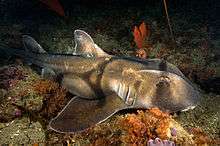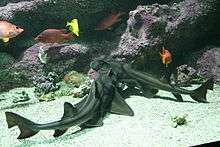Port Jackson shark
| Port Jackson shark | |
|---|---|
 | |
| Scientific classification | |
| Kingdom: | Animalia |
| Phylum: | Chordata |
| Class: | Chondrichthyes |
| Subclass: | Elasmobranchii |
| Superorder: | Selachimorpha |
| Order: | Heterodontiformes |
| Family: | Heterodontidae |
| Genus: | Heterodontus |
| Species: | H. portusjacksoni |
| Binomial name | |
| Heterodontus portusjacksoni (F. A. A. Meyer, 1793) | |
 | |
| Range of Port Jackson shark (in blue) | |
The Port Jackson shark (Heterodontus portusjacksoni) is a nocturnal, oviparous (egg laying) type of bullhead shark of the family Heterodontidae, found in the coastal region of southern Australia, including the waters off Port Jackson. It has a large, blunt head with prominent forehead ridges and dark brown harness-like markings on a lighter grey-brown body, and can grow up to 1.67 metres (5.5 ft) long.[1]
The Port Jackson shark is a migratory species, traveling south in the summer and returning north to breed in the winter. It feeds on hard-shelled mollusks, crustaceans, sea urchins, and fish. Identification of this species is very easy due to the pattern of harness-like markings which crosses the eyes, runs along the back to the first dorsal fin, then crosses the side of the body, in addition to the spine in front of both dorsal fins.
Distribution and habitat
The Port Jackson shark is endemic to the temperate waters around southern Australia and can be found in an area stretching from southern Queensland, south to Tasmania, and west to the central coast of Western Australia. Dubious reports exist of catchings as far north as Western Australia's York Sound, and on one occasion, it has occurred off the coast of New Zealand. Genetic studies suggest two Australian groups, one found from Northeastern Victoria to Western Australia and the second found from Southern Queensland to New South Wales. The species is believed to have originated somewhere off the coast of South Africa.[2] It usually lives at depths of less than 100 metres (330 ft), but has been known to go as deep as 275 metres (902 ft).[3]
The shark's territory is habitually on or near the sea bottom, which is also its feeding area.[4] Rocky environments are the most common habitat, though sandy and muddy ones, as well as seagrass beds, are sometimes used.[3] During the day, when it is usually not active, it can be found in flat areas which offer some shelter from currents (including caves)[5] or near other sheltering positions such as rocky outcrops.
Appearance
Port Jackson sharks are similar to others of their genus, bearing a broad, blunt, flat head, an anal fin, and crests above its eyes. However, the species possesses characteristics that make them easily identifiable, such as their teeth and the harness-like markings which run for a majority of their body length. These markings runs from their eyes to their first dorsal fin and then across the rest of their bodies. Both dorsal fins are of close to equal size, each with a spine at the foremost edge. These spines are rumored to be poisonous.[3] Other features that help distinguish them are their small mouths as well as their nostrils, which are connected to their mouths.[5]
The sharks have gray-brown bodies covered by black banding, which covers a large portion of their sides and backs. One of these bands winds over the face and progresses even to the shark's eyes. Another harness-shaped band goes around the back, continuing until the pectoral fins and sides. Thin, dark stripes are also present on the backs of Port Jackson sharks. These progress from the caudal fin to the first dorsal fin.[5]

Teeth
The teeth of the Port Jackson shark are one of its most distinguishable feature. Unlike other sharks, its teeth are different in the front and back. The front teeth are small, sharp and pointed, while the back teeth are flat and blunt. These teeth function to hold and break, then crush and grind the shells of the mollusks and echinoderms upon which this species feeds. Juveniles of the species have sharper teeth and their diet has a higher proportion of soft-bodied prey than adults.[3]
Respiratory system
The Port Jackson shark has five gills, the first supports only a single row of gill filaments, while the remaining four support double rows of filaments. Each of the second to the fifth gill arches supports a sheet of muscular and connective tissue called a septum. The shark possesses behind each eye an accessory respiratory organ called a spiracle. Along the top and bottom of each gill filament are delicate, closely packed, transverse flaps of gill tissue known as secondary lamellae. It is these lamellae that are the actual sites of gas exchange. Each lamella is equipped with tiny arteries that carry blood in a direction opposite to that of the water flowing over them. To compensate for the relatively low concentration of dissolved oxygen in seawater, water passes over the secondary lamellae of sharks some 5% as fast as air that remains in contact with the equivalent gas exchange sites, such as the alveoli of the lungs found in humans. This delay allows sufficient time for dissolved oxygen to diffuse into a shark's blood.
Port Jackson sharks have the ability to eat and breathe at the same time. This ability is unusual for sharks which mostly need to swim with their mouths open to force water over the gills. The Port Jackson shark can pump water into the first enlarged gill slit and out through the other four gill slits. By pumping water across the gills, the shark does not need to move to breathe. It can lie on the bottom for long periods of time.
Reproduction
Male Port Jackson sharks become sexually mature between ages 8 and 10, and females at 11 to 14. They are oviparous, meaning that they lay eggs rather than give live birth to their young. The species has an annual breeding cycle which begins in late August and continues until the middle of November. During this time, the female lays pairs of eggs every 10 to 14 days. As many as eight pairs can be laid during this period. The eggs mature for 10–11 months before the hatchlings, known as neonates, can break out of the egg capsule. The eggs have been assessed in recent studies as having an 89.1% mortality rate, mostly from predation.[5]
Digestive system
Digestion of food can take a long time in the Port Jackson shark. Food moves from the mouth to the J-shaped stomach, where it is stored and initial digestion occurs. Unwanted items may never get any further than the stomach, and are coughed up again. They have the ability to turn their stomachs inside out and spit it out of their mouths to get rid of any unwanted contents. One of the biggest differences in digestion in the shark when compared to mammals is the extremely short intestine. This short length is achieved by the spiral valve with multiple turns within a single short section instead of a very long tube-like intestine. The valve provides a very long surface area for the digestion of food, requiring it to pass around inside the apparently short gut until fully digested, when remaining waste products pass by. The most obvious internal organ in sharks is the huge liver, which often fills most of the body cavity. Dietary items include sea urchins, molluscs, crustaceans, and fishes. Black sea urchins (Centrostephanus rodgersii) are often eaten. Port Jackson Sharks forage for food at night when their prey are most active. They often use caves and rocky outcrops as protection during the day.
The teeth of the Port Jackson shark are very different from other shark species. They are not serrated, and the front teeth have a very different shape from those found at the back of the jaws, hence the genus name Heterodontus (from the Greek heteros, meaning different, and dont, meaning tooth). The anterior teeth are small and pointed, whereas the posterior teeth are broad and flat. The teeth function to hold and break, then crush and grind the shells of molluscs and echinoderms. Juvenile Port Jackson sharks have more pointed teeth and feed on a higher proportion of soft-bodied prey than adults. They can feed by sucking in water and sand from the bottom, blowing the sand out of the gill slits, and retaining the food, which is swallowed.
Relationship with humans
The shark has no major importance to humans. It is not an endangered species and is not used as a common food supply. It is, however, useful when scientists are hoping to study bottom-dwelling sharks and can be vulnerable to being caught as bycatch. It also does not pose any danger to humans.[5] In October 2011. a man was 'bitten' by a Port Jackson shark at Elwood Beach near Melbourne. The bite did not pierce the skin and the man was able to swim away while the shark was latched on to his calf.[6]
Conservation
Although listed as "Least Concern" on the World Conservation Union (IUCN) Red List, the shark's egg capsules experience very high mortality rates (estimated at 89.1%). Its status is otherwise largely unknown. Predators of the species are also unknown. Though crested bullhead shark (Heterodontus galeatus) are known to prey upon Port Jackson shark embryos, the biggest threat is probably from other sharks such as white sharks and the broadnose sevengill shark (Notorynchus cepedianus).[5]
Gallery
 Port Jackson shark's jaw
Port Jackson shark's jaw Detail of Port Jackson shark's jaw
Detail of Port Jackson shark's jaw
References
- ↑ Kindersley, Dorling (2001,2005). Animal. New York City: DK Publishing. ISBN 0-7894-7764-5. Check date values in:
|date=(help) - ↑ Burton, p. 2027.
- 1 2 3 4 M. McGrouther (October 2006). "Port Jackson Shark". Australian Museum. Retrieved March 26, 2009.
- ↑ Dianne J. Bray, 2011, Port Jackson Shark, Heterodontus portusjacksoni, in Fishes of Australia, accessed 26 Aug 2014, http://www.fishesofaustralia.net.au/home/species/1982
- 1 2 3 4 5 6 Rebecca Sarah Thaler. "Port Jackson Shark". Florida Museum of Natural History. Retrieved March 27, 2009.
- ↑ "Man bitten by shark at Elwood beach".
- Froese, Rainer and Pauly, Daniel, eds. (2006). "Heterodontus portusjacksoni" in FishBase. 06 2006 version.
- "Heterodontus portusjacksoni". Integrated Taxonomic Information System. Retrieved 13 June 2006.
Bibliography
- Robert Burton (2002). International Wildlife Encyclopedia. Marshall Cavendish.
External links
- Information from the Australian Museum site
- Photographs and information from the Marine Species Gallery of Scuba Equipment USA
- Port Jackson Shark info from Abyss Scuba Diving
